Introduction
Overall Design
{{section_header}}{{section.name}}{{/section_header}}
The Sony KDL-52EX700 is good looking television. It doesn't have the 'wow... that's cool (I guess)' factor that the NX700 sister series offers, however, which has a single piece of glass that covers the entire facade.
Front
{{section_header}}{{section.name}}{{/section_header}}
The Sony KDL-52EX700 has a simple, attractive front. The bezel around three sides is a shiny, black plastic. The bottom edge is a kind of metallic material, with some indicator lights embedded within.

Back
{{section_header}}{{section.name}}{{/section_header}}
The back of the Sony KDL-52EX700 is big and unadorned, save for some ports gathered in one corner.

Sides
{{section_header}}{{section.name}}{{/section_header}}
The Sony KDL-52EX700 is thin, but not as thin as we've seen from some other edge-lit LED televisions. On one side of the TV are the onboard controls, and on the other side are some ports.

Stand/Mount
{{section_header}}{{section.name}}{{/section_header}}
The stand on the Sony KDL-52EX700 swivels, so we're glad for that. It's made of the same glossy, black plastic as the TV's bezel.

Controls
{{section_header}}{{section.name}}{{/section_header}}
The buttons on the side of the Sony KDL-52EX700 are rather small, but in time you'll be able to perform some of the basic functions without even looking at them.

Remote Control
{{section_header}}{{section.name}}{{/section_header}}
The remote control that comes with the Sony KDL-52EX700 is decent, but feels cheap in your hand. Part of the problem is that the entire back slides out to fit the batteries. As a result, the cavity creaks and echoes every time you push a button.

In the Box
{{section_header}}{{section.name}}{{/section_header}}
The Sony KDL-52EX700 ships with a remote control, batteries, stand, AC cable, and some documentation. Assembling the TV was no great trick, as long as you read the instructions first.
Black Level
{{section_header}}{{section.name}}{{/section_header}}
The Sony KDL-52EX700 did well on the black level test. The Panasonic was the winner here, which is no surprise, given that its a plasma display. The KDL-52EX700 was more or less the same as last year's Sony KDL-52XBR9, though it's not necessarily a direct upgrade. The Samsung UN55C7000 produced the least impressive black level of the bunch. More on how we test black level.
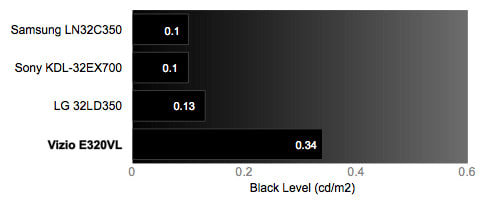
Peak Brightness
{{section_header}}{{section.name}}{{/section_header}}
The Sony KDL-52EX700 produced a very bright white. In fact, it kind of hurts to look at an all-white screen if you're in a dark room. On the plus side, this means that even if your living room was brightly lit on a sunny afternoon, you'll have no problem seeing the screen. Only the Panasonic TC-P50VT20 failed this test, but if you don't mind compromising your black level, boosting the Contrast setting to raise the whites. More on how we test peak brightness.
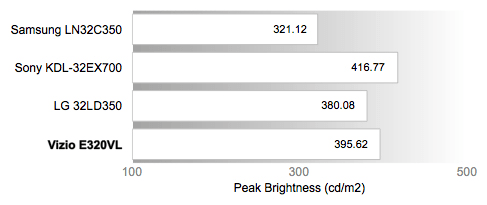
Contrast
{{section_header}}{{section.name}}{{/section_header}}
The contrast ratio on the Sony KDL-52EX700 is very good, a little over 4000:1. It was a match for a Sony TV from last year, and trumped both the Panasonic TC-P50TV20 and Samsung UN55C7000. Of course, these numbers may pale compared to the contrast ratios that manufacturers like to cite. Our lab tests try to emulate more what you would experience in real world viewing. More on how we test contrast.

Tunnel Contrast
{{section_header}}{{section.name}}{{/section_header}}
The Sony KDL-52EX700 is sufficiently capable of maintaining a consistent black level, no matter how much of that black area is surrounded by bright white. We expect an even performance from LCD televisions; plasmas tend to have problems on this test. More on how we test tunnel contrast.
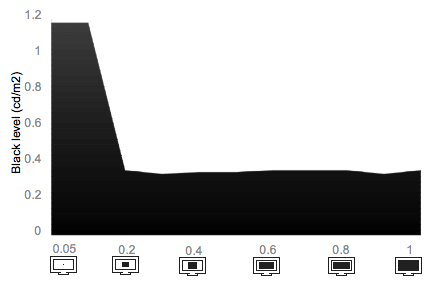
White Falloff
{{section_header}}{{section.name}}{{/section_header}}
The Sony KDL-52EX700 is also fine at maintaining an evenly bright white, no matter how much or how little of the screen was taken up by that white. More on how we test white falloff.
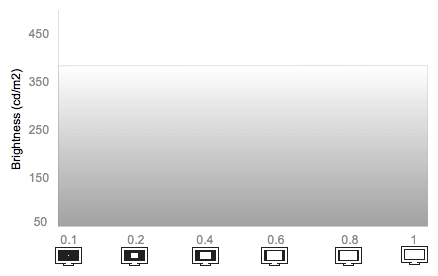
Uniformity
Greyscale Gamma
{{section_header}}{{section.name}}{{/section_header}}
The Sony KDL-52EX700 produced decent results in our greyscale gamma test. As you can see from the chart below, the line is fairly smooth, which means the TV is capable of producing a gradual transition across the greyscale. There's a little bumpiness in the lower left, which represents the shadows. This means you may lose a little detail there. The slope of the curve is steeper than we'd like. An ideal curve should fall between 2.1 and 2.2. The Sony KDL-52EX700's slope of 2.68 indicates that the greyscale spectrum may lack some of the finer details in the mid-tones. More on how we test greyscale gamma.
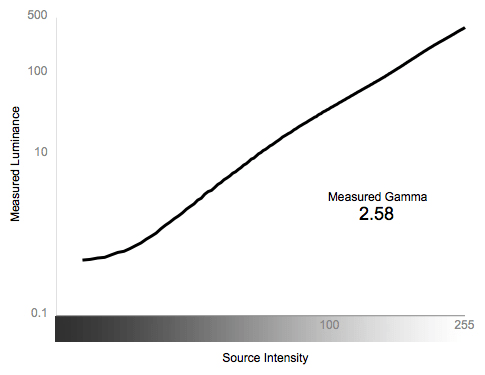
Color Temperature
{{section_header}}{{section.name}}{{/section_header}}
The Sony KDL-52EX700 could have managed a better score here in the color temperature consistency test. The image had a problem with warming as it moved through the intensity range. Practically speaking, you might be able to look at the screen and say, 'this looks a bit warm,' but whether or not that negatively impacts your viewing experience is up to what kind of cinephile you are. More on how we test color temperature.

RGB Curves
{{section_header}}{{section.name}}{{/section_header}}
The Sony KDL-52EX700's color curves were not quite perfect. As you can see from the chart below, the red, green, and blue channels didn't all quite meet up to form a single line, and each has its own little bumps. These bumps, in everyday viewing, would appear as areas of color banding. There are no major problem areas, but the blue channel probably looks the worst.
We also noticed the blue channel peaked, visualized by that horizontal tailing off at the top-right end of the blue line. This means that the KDL-52EX700 has trouble finding any detail in the brightest parts of the blue channel. More on how we test RGB curves.

The color strips below are digital recreations of the performance of each channel. Clearly, none of these TVs are matching up with the Ideal Response, but the Sony KDL-52EX700 did pretty well.
Motion Performance
{{section_header}}{{section.name}}{{/section_header}}
Motion Smoothness (8.25)
The Sony KDL-52EX700 produced an excellent smoothness of motion in our lab tests. To get the best results, we opted to turn on the MotionFlow feature. Typically, features like these that mess with the appearance of moving objects tend to make the image look worse. But if we left the MotionFlow in the lowest setting (Standard), there was a definite improvement in the maintenance of fine detail. There are some instances, though, in which you don't like the smoothing effects of MotionFlow. For instance, some of us found it distracting when watching a movie or dramatic television. If that's the case, it's very easy to turn on and off at will. (More on how we test Motion.)
Motion Artifacting (7.75)
There's always some level of artifacting when objects are in motion, because sometimes pixels simply can't refresh fast enough, or the processor can't keep up. Manufacturers are betting (correctly) that there's a certain level of blur or artifacting that you just won't notice, so there's no need to put a Cray supercomputer in the TV to produce pixel-perfect renderings. In the case of the Sony KDL-52EX700, we noticed some judders along areas of high contrast, most noticeably when the object is a straight line. There was also some minor false coloration, but nothing that will distract you too much. Overall, theTV did a fine job. More on how we test motion performance.
3:2 Pulldown & 24fps
{{section_header}}{{section.name}}{{/section_header}}
The Sony KDL-52EX700 could display 3:2 pulldown without any real troubles. In order to avoid some of the juddery motion that can occur with native 24fps footage, it's worth experimenting with the TV's CineMotion feature, designed specifically for this task. More on how we test 3:2 pulldown and 24fps.
Resolution Scaling
{{section_header}}{{section.name}}{{/section_header}}
The Sony KDL-52EX700 performed decently in the resolution scaling test. This TV has a native resolution of 1920 x 1080, but a lot of the video is likely going to be of a lower resolution.It's the TV's job to upscale this so it fits on the screen. More on how we test resolution scaling.
480p
Content in the 480p format looks very good, though it loses quite of lot of the screen's edge due to overscan.
720p
Content in the 720p format still lost 2% of the screen edge because of overscan, and we saw some Moire patterns appear in high-frequency patterns.
1080i
Content in the 1080i format, which is quite a common resolution for high definition cable TV, also lost 2% due to overscan. The instances of Moire patterns were worse than with the 720p content. Overall, the TV's 1080i performance was a little disappointing.
Formats
{{section_header}}{{section.name}}{{/section_header}}
The Sony KDL-52EX700 has a native 1080p display, with a 1920 x 1080 resolution, but is capable of playing any NTSC format.
Viewing Angle
{{section_header}}{{section.name}}{{/section_header}}
The viewing angle on the Sony KDL-52EX700 is average for an LCD television, measuring about 51 degrees (or 25.6 degrees from center on either side). Past 51 degrees, it's not like you can't see the image anymore, but the contrast ratio drops off significantly. As you can see in the chart below, the three LCD TVs scored similarly, but the Panasonic plasma TV was much better.

Reflectance
{{section_header}}{{section.name}}{{/section_header}}
The Sony KDL-52EX700, like most LCD screens, has an element in the display that helps diminish screen reflectance. Rather than shining right back at you like a mirror, the screen diffuses and disperses the light in a star-like pattern. While this pattern can be even more distracting than a simple reflection, it only appears if the light is shining dead-on against the screen. More often, things like overhead lights and table lamps are coming in at an angle, which the KDL-52EX700 does a good job of minimizing.
Video Processing
{{section_header}}{{section.name}}{{/section_header}}
The Sony KDL-52EX700 has several video processing features that you access through the menu. Most of them don't do much, but the Motionflow can lead to strange looking video, if you turn it up to high.
Calibration
{{section_header}}{{section.name}}{{/section_header}}
The calibration process for the Sony KDL-52EX700 started by putting the TV in custom mode, thereby giving us full access to all the controls. (If a control below is not mentioned, it simply indicates that we did not change it.)

All of our calibration is done in conjunction with the DisplayMate software.
](http://www.displaymate.com/)
Video Modes
{{section_header}}{{section.name}}{{/section_header}}
There are three video modes on the Sony KDL-52EX700.
Ergonomics & Durability
{{section_header}}{{section.name}}{{/section_header}}
The remote that comes with the Sony KDL-52EX700 is the same one that comes with most of Sony's HDTVs this year. We don't love the design. Rather than having a little battery cavity with an access panel, the entire back half of the remote slides out. Though it looks cool at first glance, the design seems to have created some stability problems. The whole remote creaks, groans, or echoes with each button press.
Button Layout & Use
{{section_header}}{{section.name}}{{/section_header}}
The button layout on the remote is decent, though it will probably take the normal learning curve to get used to the placement and feel. The d-pad in the center is the main menu navigation tool, and it has good action. But the buttons surrounding the d-pad are tool close together and arranged in a confusing circular pattern. It's harder to use the remote without looking down than on remotes from Panasonic, Samsung, and others.
Programming & Flexibility
{{section_header}}{{section.name}}{{/section_header}}
The remote control works with other Sony devices, but nothing outside the Sony family.
Connectivity
{{section_header}}{{section.name}}{{/section_header}}
Input Ports (6.5)
The Sony KDL-52EX700 has all the ports you need to make it a hub for your home entertainment system. There are 4 HDMIs, 2 components, 1 composite, 1 VGA, 3 analog audios, a 1/8-inch (3.5mm) audio, cable/antenna, ethernet, and USB. Most of the ports are on the back, in an easy to reach spot.

A few of the ports are on the side of the TV, great for quickly swapped devices like camcorders and USB thumb drives.
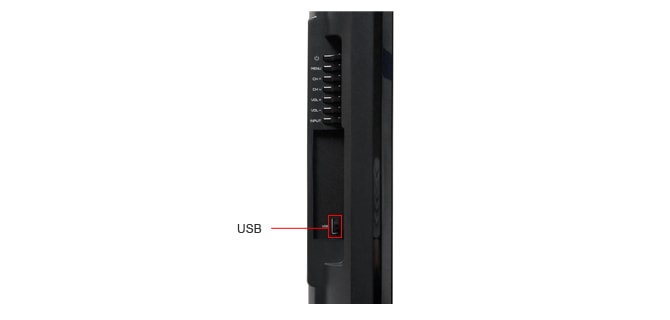
Below is a table of all the ports on the Sony KDL-52EX700 and competing TVs.
Output Ports (2.0)
The Sony KDL-52EX700 has two output ports: an analog audio out and a digital audio out. This is pretty much what you can expect from any HDTV.
Other Connections (3.0)
The Sony KDL-52EX700 has an ethernet port to feed its outstanding streaming content features.
Media (1.0)
The Sony KDL-52EX700 also has a USB port for playing back photos, audio clips, and video clips on a USB thumb drive.
{{product.manufacturer_specs['Connectivity Tour Image 3']}}
Placement
{{section_header}}{{section.name}}{{/section_header}}
The port placement is convenient, split between a handful of ports on the side and the rest on the back. Because the TV swivels on its base, you shouldn't have too much trouble seeing them. Each port is clearly labeled.
Audio Quality
{{section_header}}{{section.name}}{{/section_header}}
The audio quality of the Sony KDL-52EX700 is one of the few things that performed differently depending on the size of the unit in the series. As a kind of editorial experiment, we're reviewing every single size in the Sony EX700 line to learn how different sizes in the same series behave. The answer, for the most part, is 'quite similarly,' because they're powered by the same processor and offer identical features. But there are some physical differences to account for, and audio quality is one of them.
The 52-inch version sounds much better, side-by-side, than the 32-inch (which we happen to have in-house right now). There are a few possibilities. One, the speakers are different. Though there's no indication that they're different in the specs, we've learned not to blindly trust specs sheets. Two, the resonance of a larger cabinet allows for a different quality of sound, even if the speaker size and power is exactly the same. Either way, the 52-inch model (KDL-52EX700) sounds richer and fuller.
Of course, the sound quality doesn't compare to dedicated home theater sound system. Let's just make that clear.
Menu Interface
{{section_header}}{{section.name}}{{/section_header}}
Many Sony devices, including HDTVs, the PlayStation 3, PSP, and others, uses the XrossMediaBar menu system. It's a good menu, overall, which is why Sony has rolled it out on so many products. It's also a clever marketing strategy, because it allows you to be instantly comfortable with each additional product after your first experience.

The menu is surprisingly laggy, however, which is frustrating if you're trying to make a quick adjustment without interrupting the movie you're watching.

Instruction Manual
{{section_header}}{{section.name}}{{/section_header}}
The instruction manual that ships with the Sony KDL-52EX700 is scant. You'll find a more expanded version of the manual in the TV itself, presented as a searchable, onscreen version. Of course, if you can't even turn your TV on, the trouble-shooting section of the manual is pretty useless. You can find the Sony KDL-52EX700's manual online here.

A manual for so many TV models, they have to be further categorized by type.
Internet Features
{{section_header}}{{section.name}}{{/section_header}}
The streaming content features of the Sony KDL-52EX700, along with all the 2010 Sonys that include internet, is the best in the business. So far, no TV manufacturer is even coming close to the breadth of Sony's content partnerships, or the clean interface in which they're displayed. The complete list of channels (or apps, whatever you want to call them) is listed below. Highlights include Netflix, Amazon Video on Demand, YouTube, NPR, Wired, and more. There's also the new Sony-owned Qriocity app, which has yet to make its debut. We can only imagine that it's a service aspiring towards Netflix, drawing on the huge bank of entertainment from Sony Pictures. Four months into 2010, and we're still not sure.
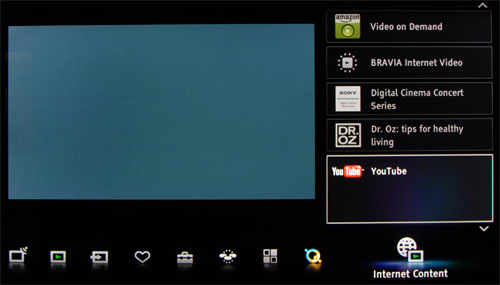
| Service | Our Description |
| Qriocity | This is Sony's soon-to-be-released streaming video service meant to compete with Netflix. Not available at time of review. |
| Michael Jackson | No joke. There's a Michael Jackson app on this TV. It includes 10 music videos, plus the trailer for This Is It and that video with the Filipino prisoners dancing to Thriller that everyone has seen a hundred times. |
| Netflix | The gold standard of streaming video. The library isn't quite perfect yet, but it's generally considered the best and new movies are added regularly. |
| Amazon on Demand | Another top-tier streaming video service, Amazon works on a pay-per-view basis rather than Netflix's subscription service. A large library of movies and TV shows. |
| YouTube | Do we really need to explain YouTube? Repository of tears and scars for the look-at-me generation. |
| Yahoo | Yahoo is like the America Online of internet video. They would call it 'edited.' We call sanitized |
| Blip.tv | Mostly quality, recurring series of internet 'TV' shows. |
| Crackle | What a completely random collection of content! It's like your uncle's DVD collection collided with your nephew's YouTube Favorites page. Dozens of episodes of original web programming, then full episodes of three TV series (What's Happening, Fantasy Island, and Action: The Series) and nine movies. Plus trailers for Sony movies. |
| FEARnet | A lackluster collection of 'scary' content. |
| Wired | Wired magazine generally has cool content. This is a collection of video. No, you can't read articles on your TV. |
| Epicurious | Food tips. This would be more useful if they organized it like an actual cookbook (sauces, meat, fish, etc) than this randomized order. |
| Concierge.com | Travel 'tips.' The average clip length is 48 seconds, including titles. This is completely useless content for the average traveler. |
| Style.com | You like fashion? Here you go. |
| Sony Digital Cinema Concert Series | Either someone at Sony loves irony, or they have some serious 90s nostalgia. This feature has concert footage from just three bands, but it's ok because it's the most amazing line-up of all time: ThirdEyeBlind, Creed, and Chickenfoot. We can only hope Sony expands this app later. |
| MyPlay Music Network | Music videos from acts likely signed with Sony music. |
| Inside Sony Pictures | Completely self-serving 'backstage pass' content from Sony Motion Pictures features. Note to Sony: a movie trailer is not really 'backstage pass' material. |
| Ford Models | The big name in modeling has its own channel. Light on content, heavy on branding. |
| DailyMotion | There are over 28,000 video in the non-HD category, and unlike the YouTube app, you can't type in text for keywords and titles. Just use your computer and don't bother with this. |
| Howcast.com | How to clean an iron. How to hold a baby. How to get someone to kiss you. Yes, all of life's mysteries answered here. |
| On Networks | Three random series of videos: Beautiful places in HD, Play Value (video game culture), and Golf Tips |
| GolfLinks.com | More golf stuff. Actually, it's well organized by topic. Epicurious would do well to take a look at this. |
| Livestrong.com | Physical health, mental health, and... beginner's guide to marriage? |
| eHow.com | Have a question you'd normally type into Google, like 'How to Remove Car Wax' or 'How do I choose my first stock.' Skip Google and choose this awkward, cursory series of instructionals instead. |
| Video Detective | Movie trailers, and not just Sony Pictures. |
| Singing Fool | Music videos. |
| Podcasts | A bunch of popular video podcasts, you can't add your own favorites to the list. |
| Videocast.com | More podcasts. |
| CBS | Do you like shows on CBS? Do you like to watch tiny clips from those shows rather than the whole episode? You'll love this brand-heavy, content-poor app. |
| Slacker | Streaming music service. Sort by genre then listen to whatever songs the service chooses to put on that channel. Great liner notes on each track, btw, if you're a music fact junkie. |
| National Public Radio | Tons of content from one of the great news organizations, but the organization here is scattershot. |
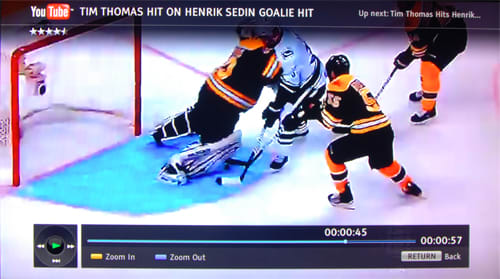
The YouTube playback is a wonderful thing.
Local Media Playback
{{section_header}}{{section.name}}{{/section_header}}
Photo Playback (3.0)
If you insert a thumb drive into the USB port, the Sony KDL-52EX700 can play back your photos with a built-in reader. The interface is not exactly simple enough to use, but it's not rocket science, either. You have to tangle with the menus (Home Menu > Photo > USB) to access photos, rather than playback starting up when you insert the drive. It would have been simpler if the 'USB' submenu popped up that listed all the contents.
There are plenty of playback options, such as creating slideshows, adding music, using transition effects, and more.
Music & Video Playback (4.0)
Like the photo playback, music and audio clip playback is done using a thumb drive and the USB port. Again, you'll find the media under submenu appropriate to the content (i.e. Music or Video), rather than the directory (i.e. USB drive). With the audio clips, you can create a music play list.
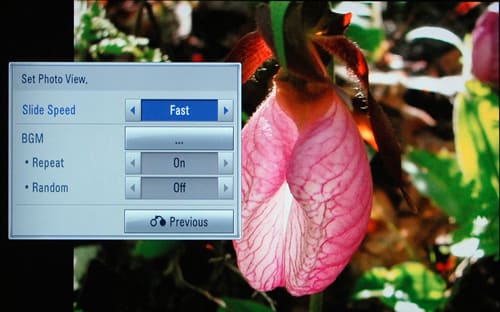
Other Media
{{section_header}}{{section.name}}{{/section_header}}
The Sony KDL-52EX700 has no other media options.
Power Consumption
{{section_header}}{{section.name}}{{/section_header}}
The EX700 series makes a definite energy saving improvement over similarly sized TVs we've reviewed, particularly a 52-inch Sony from last year. The Sony KDL-52EX700 should cost, on average, on $17.21 a year in electricity. Comparatively, the competing TVs sun up to nearly twice as much.
If you want to conserve a little more energy, you can simply turn down the backlight, an option available on all LCD TVs (not plasmas, sorry).
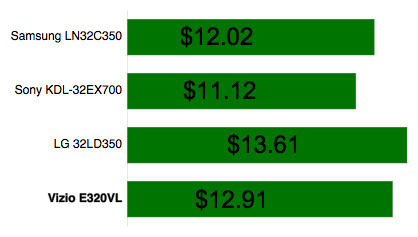
Value Comparison
{{section_header}}{{section.name}}{{/section_header}}
Overall, the Sony KDL-52EX700 is probably a better TV in most regards than the Sony KDL-52XBR9. The core performances are roughly the same, but this year's model has better internet features, the option for WiFi connectivity, and a lower starting price. Granted, you can probably find the 52XBR9 on discount by now, but a recent price slash on the 52EX700 positions it pretty strongly.
Blacks & Whites
{{section_header}}{{section.name}}{{/section_header}}
The KDL-52XBR9 had a slight advantage over the newer KDL-52EX700 in the black & white performance: black level, peak brightness, and contrast ratio. The difference is so small that it hardly exceeds a testing margin of error.

Color Accuracy
{{section_header}}{{section.name}}{{/section_header}}
The Sony KDL-52EX700 had an usually hard time with maintaining a consistent color temperature, as evinced from the charts below. The KDL-52XBR9 was not perfect, but it had far less error that would be visible to the human eye. The RGB color curve test, however, was virtually identical, and both TVs produced good scores.
Motion
{{section_header}}{{section.name}}{{/section_header}}
The motion performances from both the KDL-52EX700 and KDL-52XBR9 were quite good. We were impressed with the processing power of the newer EX7 series, especially. High marks, all around.
Viewing Effects
{{section_header}}{{section.name}}{{/section_header}}
The KDL-52EX700 and KDL-52XBR9 were more or less identical in their viewing angle.
Connectivity
{{section_header}}{{section.name}}{{/section_header}}
The Sony KDL-52EX700 has the advantage of a WiFi compatibility (with additional purchase), but it loses the S-Video and one of the analog audio inputs. Other than that, they're similarly matched.
Other Comparisons
{{section_header}}{{section.name}}{{/section_header}}
The streaming content package on the 2010 models, including the KDL-52EX700, is more robust than last year's TVs.
Value Comparison
{{section_header}}{{section.name}}{{/section_header}}
The biggest difference between these two TVs is that the Panasonic TC-P50VT20 can display in 3D, as well as standard 2D. That's a premium that clearly drives the price up, and you're either willing to pay for cutting edge technology like that or you aren't. We can say that the 3D display effect is good, but the Panasonic's screen is surprisingly dim compared to LED LCD televisions. Know what you're really paying for if you opt for the Panasonic.
Blacks & Whites
{{section_header}}{{section.name}}{{/section_header}}
The Panasonic TC-P50VT20, as a plasma screen, can get much darker than any of the other TVs in this comparison pool. But the Panasonic was terrible at producing a decent peak brightness. Side-by-side, it's impossible to not notice how much brighter the Sony KDL-52EX700 appears. As a result of these numbers, the contrast ratio on the Sony is much better.

Color Accuracy
{{section_header}}{{section.name}}{{/section_header}}
The Panasonic TC-P50VT20 did a better job maintaining a consistent color temperature than the Sony KDL-52EX700, which had a tendency to warm the whites at as the signal got darker. However, the Sony showed better, smoother RGB color curves. This means you should see less color banding on the Sony.
Motion
{{section_header}}{{section.name}}{{/section_header}}
The motion performance on both these TVs was very good. We were quite impressed with the efforts of Sony and Panasonic to create an immersive experience that avoids glaring motion problems like strobing, false coloration, or loss of detail that plagues a lot of cheaper TVs.
Viewing Effects
{{section_header}}{{section.name}}{{/section_header}}
The Panasonic TC-P50TV20 is a plasma TV, which all but guarantees a much, much wider viewing angle than all the LCD televisions in the comparison pool.
Connectivity
{{section_header}}{{section.name}}{{/section_header}}
The Panasonic TC-P50VT20 and the Sony KDL-52EX700 are similarly matched in connectivity. Both make good hubs for a home entertainment system. The Panasonic adds a second USB port and a media card slot, but it loses the analog audio output.
Other Comparisons
{{section_header}}{{section.name}}{{/section_header}}
The Panasonic's 3D display is clearly a cool feature, but do you want to pay for it. The fact is that 3D is something the manufacturers want you to want more than the public is actually asking for it. The growing ever-expanding market opportunities but low profit margins of TVs, combined with a faltering economy, have egged the big companies on to create the 'next big thing.' It's here: 3D. Try it before you buy we, we beg you.
Value Comparison
{{section_header}}{{section.name}}{{/section_header}}
The Samsung UN55C7000 is 3D display television. On top of that, you're paying for a very slick, incredibly slender design. Premiums like this don't come cheap, so you definitely need to consider your budget if you're torn between this Samsung and the Sony KDL-52EX700. The Samsung lacks the outstanding streaming content options, but counters with a truly excellent picture quality and, for what it's worth, three extra inches of screen.
Blacks & Whites
{{section_header}}{{section.name}}{{/section_header}}
The Black & White performance isn't quite as good as the Sony KDL-52EX700. The blacks are noticeably less black, if they were side-by-side. There's a gap in the peak brightness performance, as well, but this would be harder to see. Both are sufficiently bright.

Color Accuracy
{{section_header}}{{section.name}}{{/section_header}}
The Samsung UN55C7000 managed to maintain a better color temperature consistency than the Sony KDL-52EX700, though the Samsung was not perfect. As you can see from the charts below, the Samsung gets a little warm as the signal ebbs, but the Sony has more visible error across the spectrum. The RGB color curve analysis was more closely matched. Both TVs were quite good.
Motion
{{section_header}}{{section.name}}{{/section_header}}
The Samsung UN55C7000 and the Sony KDL-52EX700 are both excellent televisions when it comes to motion quality. We found very little wrong with either, aside from the occasional false coloration and trailing around areas of high contrast. Both TVs have added motion smoothing features that you can turn on and off to tweak performance to your taste.
Viewing Effects
{{section_header}}{{section.name}}{{/section_header}}
The Samsung UN55C7000 and the Sony KDL-52EX700 are both pretty bad at producing a decent viewing angle, as are most LCD TVs. Only the plasma-screened Panasonic did any good in this test.
Connectivity
{{section_header}}{{section.name}}{{/section_header}}
The Samsung UN55C7000 has one less component port and two fewer analog audio inputs, but counters with an additional USB and EX-LINK (if you need it). It's worth noting that because the Samsung's body is so incredibly slender, nearly every connection type requires a proprietary, intermediary adapter to plug into the TV. That means that if you lose or break them, you'll be crawling to Samsung for replacements.
Other Comparisons
{{section_header}}{{section.name}}{{/section_header}}
The Samsung UN55C7000 supports 3D display, assuming you have the proprietary 3D glasses, sold separately and at no small cost. Because it's a first-generation product, you pay a lot for that luxury. Most people will choose to sit out the first round and see how it all goes. These are the same people laughing at everyone that bought a Betamax and HD-DVD player.
Conclusion
The Sony KDL-52EX700 offers a lot for the price. Sure it's not 3D, and no, it does not have the embedded WiFi like the NX7 series, but for what it does do, it does it very well. The core performance stats are strong. The 52EX700 offers deep blacks, bright whites, smooth color curves, and great motion performance. Aesthetically, the TV is a pretty sweet looking piece of gear.
All TVs have their downsides, of course. The KDL-52EX700 showed some bad screen uniformity, and the color temperature maintenance was far from ideal. But overall, we can definitely get behind this TV, especially since Sony lowered the price almost immediately after it hit the market.
Model Series Comparison
{{section_header}}{{section.name}}{{/section_header}}
The EX7 series from Sony has several sizes, all of which offer the same great streaming content package and the option for WiFi connectivity.
Photo Gallery
{{photo_gallery "Front Tour Image", "Back Tour Image", "Sides Tour Image", "Stand Photo", "Controls Photo", "Remote Control Photo", "Connectivity Tour Image 1", "Connectivity Tour Image 2", "Connectivity Extra Photo", "Menu Main Photo", "Menu 2 Photo", "Internet Features 1 Photo", "Internet Features 2 Photo", "Internet Features 3 Photo", "Local Media Playback 1 Photo", "Local Media Playback 2 Photo"}}
Ratings & Specs
{{manufacturer_specs_table}}
Meet the tester
David Kender oversees content at Reviewed as the Editor in Chief. He served as managing editor and editor in chief of Reviewed's ancestor, CamcorderInfo.com, helping to grow the company from a tiny staff to one of the most influential online review resources. In his time at Reviewed, David has helped to launch over 100 product categories and written too many articles to count.
Checking our work.
Our team is here for one purpose: to help you buy the best stuff and love what you own. Our writers, editors, and lab technicians obsess over the products we cover to make sure you're confident and satisfied. Have a different opinion about something we recommend? Email us and we'll compare notes.
Shoot us an email
